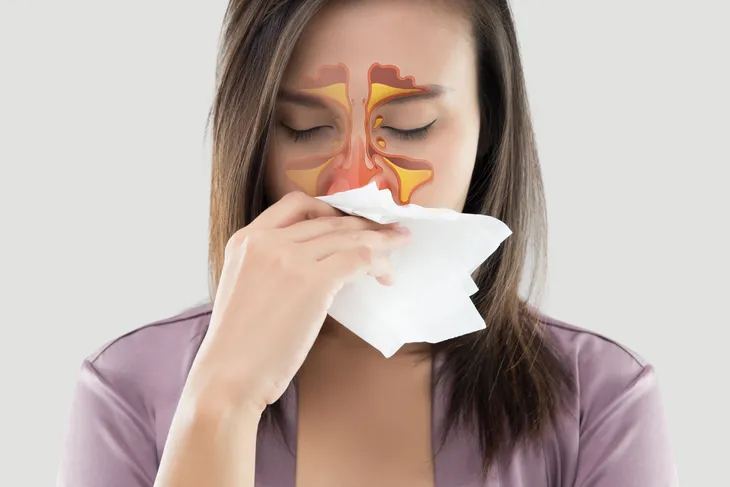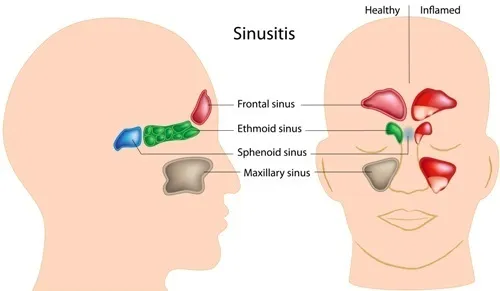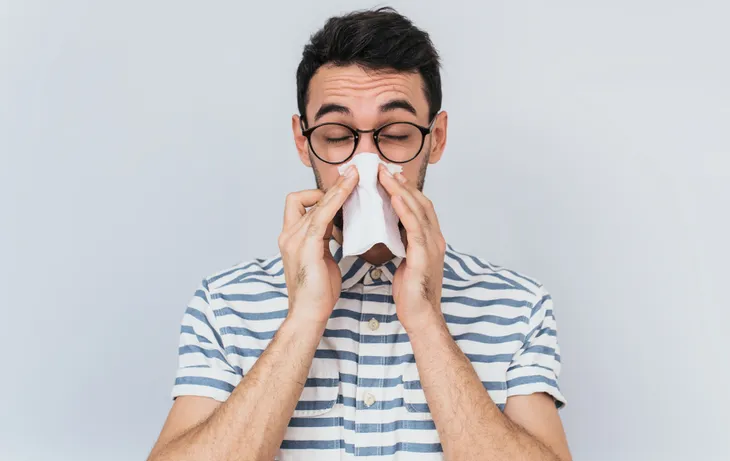- Sinus infections are one of the most common conditions treated by antibiotics and affect many people in the United States each year.
- Also called sinusitis, sinus infections refer to inflammation and swelling in the tissues of your sinuses.
- Common sinus infection symptoms include nasal congestion, fatigue, facial pressure, and postnasal drip.
Sinus infections affect over 11.6-percent of adults in the United States per year, but this diagnosis is different from a cold or allergies. Often caused by viruses and persisting for weeks, sinus infections can have many uncomfortable symptoms and lead to chronic issues or complications if left untreated.
Keep reading to learn more about sinus infections and the various causes, symptoms, and treatments. We’ll also look into what preventative measures you can take.
What Is Sinusitis?
A sinus infection, also known as sinusitis or rhinosinusitis, occurs when the tissue that lines the sinuses becomes inflamed and swollen. Usually caused by a virus, sinusitis can have symptoms that last long after other respiratory symptoms are gone.
Your sinuses consist of four cavities around your eyes, nose, cheeks, and forehead that produce mucus to keep your nasal passages moist and filter pollutants, allergens, and dust. When sinuses are inflamed and swollen, they become blocked with fluid. This blockage allows bacteria to grow and cause infections.
What Are the Types of Sinuses?
There are four pairs of sinuses that create moist and hollow spaces in a fully developed skull. Each sinus has hairlike cilia that help move mucus through various passages and cavities. Named for the corresponding bones that make up their shape, the sinuses are:
- Ethmoidal sinuses: Small spaces located in the ethmoid bone between the eyes
- Maxillary sinuses: Located in the maxillae and below the eyes
- Sphenoidal sinuses: Located in the sphenoid bone and behind the eyes
- Frontal sinuses: Triangle-shaped sinuses located above the eyes
Maxillary sinuses are the largest and most frequently infected of all sinuses.
Types of Sinusitis
There are several types of sinus infections:
- Acute sinusitis: A sudden onset of cold symptoms that last 10 or more days
- Chronic sinusitis: A sinus infection that lasts longer than 3-months
- Subacute sinusitis: Symptoms that last between 4- and 12-weeks
- Recurrent sinusitis: When symptoms reoccur several times in a year but last less than 2-weeks at a time
Acute sinusitis is common, affecting about one in eight adults per year. Chronic sinusitis affects approximately 14.6-percent of the people in the United States and ranks fifth among conditions most frequently treated with antibiotics.
The Differences Between Sinusitis, Colds, and Allergies
Colds, allergies, and sinus infections have similar symptoms but different treatments and causes. A sinus infection is a result of swelling and inflammation and has many possible causes. Symptoms can last anywhere from a few days to indefinitely (for chronic cases).
Colds are viral infections that can affect your nose, throat, and sinuses. Symptoms appear several days after exposure and peak and fade within a week, but colds can sometimes progress to a sinus infection.
Sinus allergies occur when your immune system reacts adversely to specific substances or particles and releases histamines. Sinus-related allergies can likewise result in swelling and inflammation but are caused by allergenic particles such as dust, mold, pollen, and dander.
Causes of and Risks for Sinus Infections
Sinus infections are also categorized by either viral or bacterial causes. Viral upper respiratory infections are the most common causes of sinus infections as they affect the lining of your facial and nasal cavities. Bacterial infections are much less common than viral infections.
Anyone can get sinus infections, but some individuals may be more predisposed to developing a sinus infection. Factors that increase the chance of sinus infections include:
- Nasal allergies
- Nasal polyps
- Asthma
- Structural abnormalities in the nose
- Immune system deficiencies
- Blocked drainage ducts
- Smoking
Children are usually more likely to get sinus infections as they’re often exposed to illnesses from other children at daycare or school and may ingest bacteria from toys, pacifiers, and bottles.
Symptoms of Sinusitis
Regardless of whether sinus infections are acute or chronic, the symptoms are usually the same. The symptoms of sinus infections are:
- Nasal congestion
- Postnasal drip
- Facial pain or pressure around the nose, eyes, and forehead
- Halitosis or bad breath
- Cough
- Fatigue
- Fever
- Toothaches
- Loss of smell
- Thick, green, or yellow nasal discharge
- Stiff neck
Symptoms can sometimes worsen or compound if you have chronic sinusitis. As your body continually works hard to fight the infection, you may feel increasingly fatigued. You may also experience pus in the nasal cavity.
Potential Complications
Although treating a sinus infection is generally simple, allowing it to go untreated can lead to serious complications. The walls of your sinuses are thin and share lymph drainage pathways and blood vessels with nearby parts of your body, including your eyes and brain. If the infection is allowed to spread, it can lead to issues such as:
- Eye infections
- Meningitis
- Bone infection
- Brain abscess
- Seizure
- Drooping eyelid
- Sinus cavity blood clot
- Eye or eye socket swelling
Diagnosing Sinusitis
To diagnose a sinus infection, your doctor will discuss your symptoms with you and perform a physical exam. They can often make a sinus infection diagnosis by feeling for tenderness in your sinuses and looking inside your nose and ears with an otoscope.
If they’re unsure or need to rule out other possibilities, they may take further measures. These may include using a light to see inside your nose or taking a swab to test for fungal or bacterial infection. They may also perform a nasal endoscopy, a procedure where they insert an endoscope into your nose. A lens at the end of this tool provides your doctor with a detailed look at your sinuses. For serious cases, they may order a CT scan.
 S_L / Shutterstock
S_L / ShutterstockSinusitis Treatment
Depending on the severity of your sinus infection, your doctor may suggest several treatment options. These include:
- Decongestant nasal sprays provide short-term relief for nasal congestion and swelling by shrinking blood vessels in the nasal passages.
- Antibiotics are used in serious cases of sinus infections that don’t improve on their own.
- Bioelectric device is a handheld device that emits gentle micro-current waveforms to stimulate nerves, shrink blood vessels and reduce swelling and pain.
Home Remedies for Sinusitis
There are many ways to treat sinus infections at home:
- Steam: Vaporizers or steam from warm water can help relieve congestion, facial pressure, and pain.
- Fluids: Keeping hydrated by drinking enough water, tea, or other fluids can help thin mucus and relieve nasal passage blockage.
- Saline nose drops: Saline sprays, rinses, and drops can moisten nasal tissues and help drain mucus.
- Warm compresses: Place a warm cloth or pack over your face to promote blood flow and ease pressure.
- Pain relievers: Over-the-counter pain relievers or decongesting cold medicines can relieve symptoms.
- Antihistamines: Over-the-counter antihistamines can help prevent swelling, congestion, and other symptoms.
 Shutterstock/New Africa
Shutterstock/New AfricaSurgery
If your sinus infection is chronic or recurrent, and at-home remedies can’t resolve your symptoms, it may be time to see your doctor and pursue advanced measures. If over-the-counter or prescription treatments likewise don’t work, they may recommend surgery to address structural abnormalities.
During surgery, an otolaryngologist identifies and repairs issues such as nasal polyps, closed passages, or abnormalities in the bone separating your nasal passages. Sinus surgery occurs under general anesthesia and takes between 30-minutes and 4-hours. Patients generally go home the same day and fully recover within a few weeks.
How to Prevent Sinusitis
Sinus infections are best prevented by maintaining a healthy lifestyle, treating your allergies, and avoiding others who are sick. Although there are no guaranteed ways to prevent sinus infections, the following strategies can help:
- Don’t smoke, and avoid secondhand smoke.
- Wash your hands, especially during cold and flu season.
- Avoid known allergen exposure, and avoid overusing antihistamines.
- Use a humidifier to moisten the air at home.
- Avoid contact with people who have colds, coughs, or other upper respiratory infections.
 Shutterstock/Nana_studio
Shutterstock/Nana_studio











